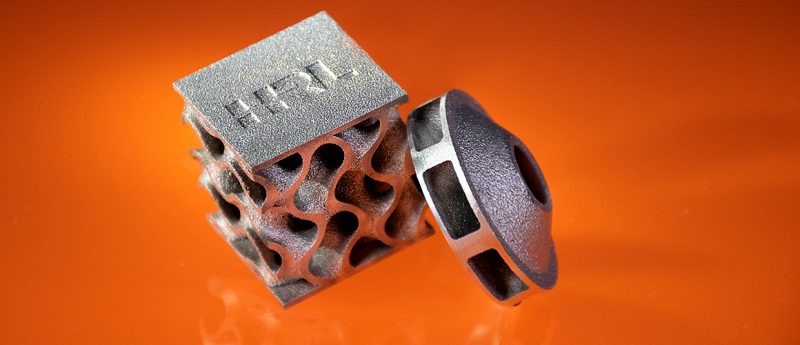
New Research Advances the Art of 3D-Printed Metal

HRL Laboratories’ understanding of how to control the microstructure of metal alloys within additive manufacturing enables them to print parts with customized targeted properties using commercially available equipment. © HRL Laboratories, TICR 20-082.
Recently Published Data Secures HRL Laboratories as Vanguard of Microstructure Control in Additive Manufacturing of High-Performance Alloys
HRL Laboratories, LLC, continues its research push to advance the state of the art in additive manufacturing (AM) of high performance alloys. The HRL AM team’s new paper elucidates the fundamental physics behind HRL’s expertise, which enables significantly improved control of how 3D-printed metals melt and solidify. The paper, Grain refinement mechanisms in additively manufactured nano-functionalized aluminum, was published online in September 2020 ahead of the November print issue of the journal Acta Materialia.
We’ve shown the benefits in aluminum alloys and we continue expanding our technology to other alloys and systems
“Additive manufacturing, as a process, provides the capability to produce almost any geometry,” said Hunter Martin, HRL’s lead metallurgical scientist. “This newly published research details our understanding of how to control the microstructure of metal alloys within an AM process. This understanding allows us to customize the process to obtain targeted properties, and then print parts using commercially available additive equipment.”
Martin described a conceptual relationship between process, structure, and property. “The process dictates what types of microstructures you can get, and the microstructures dictate what kind of properties you get. We have demonstrated our ability to control those microstructures across multiple length scales giving us the ability to control the properties of the material.”
Because HRL has entered the commercial market with its proprietary feedstock for printing high-strength aluminum, the ability to control microstructure has enabled the team to begin identifying new alloys for which they aim to control microstructure over multiple orders of magnitude.
“This fundamental research confirms principles that we alluded to in our breakthrough research on printing high-strength aluminum published in Nature in 2017. However, for customers of our high-strength aluminum feedstock, it illustrates the versatility of our approach to expand the catalogue of alloys available for additive manufacturing. As the leaders in additive microstructure control, we’ve shown the benefits in aluminum alloys and we continue expanding our technology to other alloys and systems.”
HRL’s commercial effort has successfully scaled up production processes to provide significant quantities of high-strength, AM-compatible aluminum powder to our partners and customers. Engineers who need parts with specific features that existing alloys do not meet can get a custom high-strength alloy designed for to their specifications that is printable in commercial equipment.
Co-authors on the paper with Martin include Brennan Yahata, Justin Mayer, Robert Mone, Ekaterina Stonkevitch, Julie Miller, Mark O’Masta, Tobias Schaedler, and Jacob Hundley from HRL Laboratories, as well as Patrick Callahan from the U.S. Naval Research Laboratory, and Professor Tresa Pollock from the University of California, Santa Barbara.
HRL Laboratories, LLC, California (hrl.com) pioneers the next frontiers of physical and information science. Delivering transformative technologies in automotive,aerospace and defense, HRL advances the critical missions of its customers. As a private company owned jointly by Boeing and GM, HRL is a source of innovations that advance the state of the art in profound and far-reaching ways.
Media Inquiries: media[at]hrl.com, (310) 317-5000